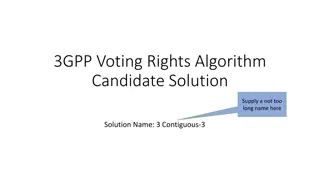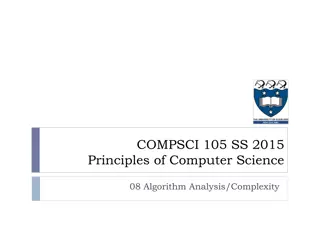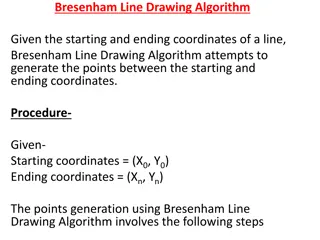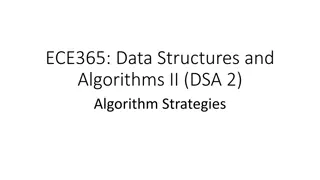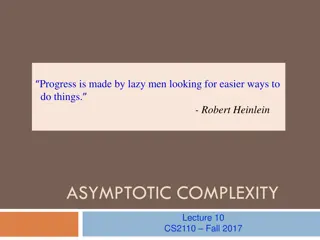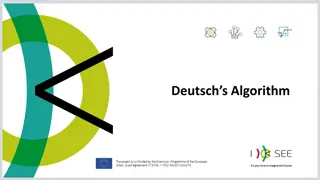Understanding Algorithm Efficiency Analysis
In this chapter, Dr. Maram Bani Younes delves into the analysis of algorithm efficiency, focusing on aspects such as order of growth, best case scenarios, and empirical analysis of time efficiency. The dimensions of generality, simplicity, time efficiency, and space efficiency are explored, with a distinction between theoretical and empirical analysis approaches. Theoretical analysis of time efficiency involves determining the number of times a basic operation is executed as a function of input size, while considering different basic operations that may vary in cost. The importance of measuring input size in evaluating algorithm efficiency is emphasized through examples of basic operations corresponding to different problem inputs. This thorough examination sheds light on how time complexity and space complexity impact algorithm performance.
Download Presentation

Please find below an Image/Link to download the presentation.
The content on the website is provided AS IS for your information and personal use only. It may not be sold, licensed, or shared on other websites without obtaining consent from the author. Download presentation by click this link. If you encounter any issues during the download, it is possible that the publisher has removed the file from their server.
E N D
Presentation Transcript
ANALYSIS OF ALGORITHM EFFICIENCY CHAPTER 2 DR. MARAM BANI YOUNES
CONTENTS Analysis of Algorithms Order of Growth Best Case, Average Case, Worst Case Calculating The Running Time of a program Analysing the Time Efficiency of Non-recursive Algorithms Analysing the Time Efficiency of Recursive Algorithms Empirical analysis of time efficiency
ANALYSIS OF ALGORITHMS Dimensions: Generality Simplicity Time efficiency Space efficiency The term analysis of algorithms is usually used in a narrower, technical sense to mean an investigation of an algorithm s efficiency with respect to two resources: running time and memory space Approaches: Theoretical analysis Empirical analysis
ANALYSIS OF ALGORITHMS Time efficiency, also called time complexity, indicates how fast an algorithm runs. Space efficiency, also called space complexity, refers to the amount of memory units required by the algorithm in addition to the space needed for its input and output.
THEORETICAL ANALYSIS OF TIME EFFICIENCY Time efficiency is analyzed by determining the number of repetitions of the basic operation as a function of input size Basic operation: the operation that contributes the most towards the running time of the algorithm input size T(n) copC(n) running time Number of times basic operation is executed execution time for basic operation or cost Note: Different basic operations may cost differently!
MEASURING THE INPUTS SIZE Almost all algorithms run longer on larger inputs. For example, it takes longer to sort larger arrays, multiply larger matrices, and so on. Therefore, it is logical to investigate an algorithm s efficiency as a function of some parameter nindicating the algorithm s input size
INPUT SIZE AND BASIC OPERATION EXAMPLES Problem Input size measure Basic operation Searching for key in a list of n items Key comparison Number of list s items, i.e. n Matrix dimensions or total number of elements Multiplication of two matrices Multiplication of two numbers Checking primality of a given integer n n size = number of digits (in binary representation) Division Visiting a vertex or traversing an edge Typical graph problem #vertices and/or edges
TYPES OF FORMULAS FOR BASIC OPERATION S COUNT Exact formula e.g., C(n) = n(n-1)/2 Formula indicating order of growth with specific multiplicative constant e.g., C(n) 0.5 n2 Formula indicating order of growth with unknown multiplicative constant e.g., C(n) cn2
ORDER OF GROWTH Most important: Order of growth within a constant multiple as n Example: How much faster will algorithm run on computer that is twice as fast? How much longer does it take to solve problem of double input size?
UNITS FOR MEASURING RUNNING TIME T(n) copC(n) How much faster would this algorithm run on a machine that is 10 times faster than the one we have? The answer is, obviously, 10 times. Assuming that ? ? =1 2? ? 1 , how much longer will the algorithm run if we double its input size? The answer is about four times longer. ? ? =1 2? ? 1 =1 1 2? 1 2?2 2?2 1 2(2?)2 1 ?(?) copC(2n) ?(2?) 2?2= 4 copC(n) cop was neatly cancelled out in the ratio Multiplicative constant in the formula for the count C(n) which is 1 2, was also cancelled out The efficiency analysis framework ignores multiplicative constants and concentrates on the count s order of growth to within a constant multiple for large-size inputs.
VALUES OF SOME IMPORTANT FUNCTIONS AS N
EXAMPLE: SEQUENTIAL SEARCH Worst case: n key comparisons when there are no matching elements or the first matching element happens to be the last one on the list Best case: 1 comparisons When the list of size n with its first element equals to a search key Average case: K is in A => (n+1)/2 key comparisons K is not in A => n key comparisons
BEST-CASE, AVERAGE-CASE, WORST-CASE For some algorithms, efficiency depends on form of input: Worst case: Cworst(n) maximum over inputs of size n The worst-case efficiency of an algorithm is its efficiency for the worst-case input of size n, which is an input (or inputs) of size n for which the algorithm runs the longest among all possible inputs of that size. Best case: Cbest(n) minimum over inputs of size n The best-case efficiency of an algorithm is its efficiency for the best-case input of size n, which is an input (or inputs) of sizen for which the algorithm runs the fastest among all possible inputs of that size. Average case: Cavg(n) average over inputs of size n Number of times the basic operation will be executed on typical input NOT the average of worst and best case
CALCULATING THE RUNNING TIME OF A PROGRAM (SIMPLE ASSIGNMENT STATEMENT) Suppose we have the following segment of a program: A simple assignment statement to an integer variable. a=b Since the assignment statement takes constant time, so its complexity is O(1).
CALCULATING THE RUNNING TIME OF A PROGRAM (SIMPLE FOR LOOP) Consider a simple for loop = 0 sum = 1 for i to n = + sum sum n The cost of the entire code fragment (complexity) is n + = ( ) ( ) O c c O n 1 2 = 1 i
CALCULATING THE RUNNING TIME OF A PROGRAM (SEVERAL FOR LOOPS) Consider a code fragment with several for loops, some of which are nested The total cost is = 0 sum j n n = 1 for j to = n = = = + + = 2 ( ) ( ) O c c c O n 1 2 3 1 for i to j = 1 1 0 j i k = + 1 sum 0 sum = ( for k to = n ) a k k
CALCULATING THE RUNNING TIME OF A PROGRAM (SEVERAL FOR LOOPS) 1 sum ) Compare the asymptotic analysis for the following two code fragments: = i 0 = 1 for to n = 1 for j to n = + 1 sum sum 2 sum ) 2 ( ) O n Thus, both double loops cost = i 0 = 1 for to n = Although the 2nd requires about the time of the 1st. 1 for j to i = + 1 sum sum
NOTE Not all the doubly nested loops are 2 ( ) O n
SUMMATION FORMULAS AND RULES USEFUL IN ANALYSIS OF ALGORITHMS
GENERAL PLAN FOR ANALYZING THE TIME EFFICIENCY OF NONRECURSIVE ALGORITHMS 1. Decide on a parameter (or parameters) indicating an input s size. 2. Identify the algorithm s basic operation. (As a rule, it is located in the innermost loop.) 3. Check whether the number of times the basic operation is executed depends only on the size of an input. If it also depends on some additional property, the worst-case, average-case, and, if necessary, best-case efficiencies have to be investigated separately. 4. Set up a sum expressing the number of times the algorithm s basic operation is executed. 5. Using standard formulas and rules of sum manipulation, either find a closed form formula for the count or, at the very least, establish its order of growth.
EXAMPLE 1 = 0 sum Thus the time is = 1 k + lg = 1 n n + + + ( ( )) O c c c c while k n 1 2 3 4 = 1 + 1 k j { = + + ( ( lg 1 )) O c c c n n 1 n 2 3 = sum 1 for j to n = ( lg ) O n = + 1 sum = 2 k k }
SEE TUTORIAL # 1 NON-RECURSIVE EXAMPLES: TIME COMPLEXITY
MATHEMATICAL ANALYSIS OF RECURSIVE ALGORITHMS Determining the execution time of a recursive subroutine can be particularly difficult. The running time for a recursive subroutine is typically best expressed by recurrence relation.
GENERAL PLAN FOR ANALYZING THE TIME EFFICIENCY OF RECURSIVE ALGORITHMS 1. Decide on a parameter (or parameters) indicating an input s size. 2. Identify the algorithm s basic operation. 3. Check whether the number of times the basic operation is executed can vary on different inputs of the same size; if it can, the worst-case, average-case, and best-case efficiencies must be investigated separately. 4. Set up a recurrence relation, with an appropriate initial condition, for the number of times the basic operation is executed. 5. Solve the recurrence or, at least, ascertain the order of growth of its solution
EXAMPLE 1: FACTORIAL For simplicity, we consider n itself as an indicator of this algorithm s input size (rather than the number of bits in its binary expansion) The basic operation of the algorithm is multiplication, whose number of executions we denote M(n). we use what can be called the method of backward substitutions Take advantage of the initial condition given. Since it is specified for n = 0, we have to substitute i = n in the pattern s formula to get the ultimate result of our backward substitutions
SEE TUTORIAL # 2 MATHEMATICAL ANALYSIS OF RECURSIVE ALGORITHMS
EMPIRICAL ANALYSIS OF TIME EFFICIENCY
EMPIRICAL ANALYSIS OF TIME EFFICIENCY Select a specific (typical) sample of inputs Use physical unit of time (e.g., milliseconds) or Count actual number of basic operation s executions Analyze the empirical data

















